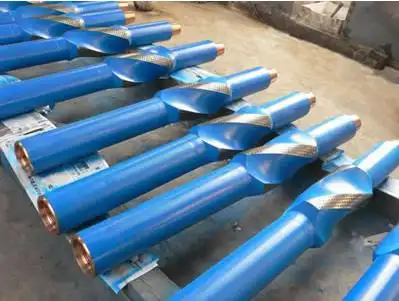1.Introduction to the stabilizer
The stabilizer is a cementing tool that is easy to manufacture, has a beautiful structure, is sturdy and durable, and has a strong straightening force. It overcomes the shortcomings of the original welded stabilizer, which is prone to detachment, and is a stabilizer that can ensure the quality of drilling and cementing.
There are various types of stabilizers, which can be divided into roller type, slider type, automatic reversing type, etc. according to their structure. Centralizers with different structures and materials are suitable for oil wells with different types of eccentric wear. The key technology for using stabilizers to prevent eccentric wear is the installation position, spacing, and quantity of stabilizers.
2.Purpose of stabilizer
Due to the complexity of the well conditions, the following problems often occur during the production process of pumping unit wells.
l Misalignment of sucker rod: Misalignment of sucker rod can reduce the production efficiency of the pumping unit well and increase production costs.
l Low pump efficiency: Due to increased friction in the upper stroke caused by eccentric wear, the load on the pumping unit is increased, energy consumption is increased, stroke loss is large, and pump efficiency is low;
l As the water content of the output increases, the specific gravity of the output increases, which increases the load on the oil pump and leads to increased leakage, resulting in a decrease in pump efficiency.
3.Principle of stabilizer
Centralizer is a new type of oil production tool used in oil field pumping wells, which can improve the pumping efficiency of oil pumps; It adopts a sliding valve automatic opening and closing structure, connected to the sucker rod. When the sucker rod moves down, the slide valve opens the oil passage on the stabilizer body when it moves up, and when the sucker rod moves up, the slide valve closes the oil passage on the stabilizer body when it moves down. Thus, by lifting the liquid column in sections, the load on the pumping rod and pump can be reduced in sections, reducing pump leakage, minimizing the elastic elongation deformation of the pumping rod, reducing stroke loss, thereby improving the effective stroke of the pumping pump, increasing the filling amount of the pump barrel, and improving pump efficiency.
4.Installation and use of stabilizer
l Principle of minimizing stroke loss
According to the combination of sucker rods, it is recommended to install 4-10 of this product every 1000 meters to minimize the load on the longest extended sucker rod as much as possible.
l According to the oil quality
This product adopts a sliding valve automatic opening and closing structure, which can prevent the body from scaling and waxing. However, when installing this product, try to avoid waxing points as much as possible. (Using our factory’s viscosity reducing, wax preventing, and liquid increasing stabilizer can prevent this situation from happening)
l According to the curvature of the well
This product should be appropriately increased in installation density in areas with severe eccentric wear in oil wells, which can better straighten the sucker rod.
l Pay attention to avoiding the oil pipe coupling as much as possible for this product.
Post time: Jan-03-2025





